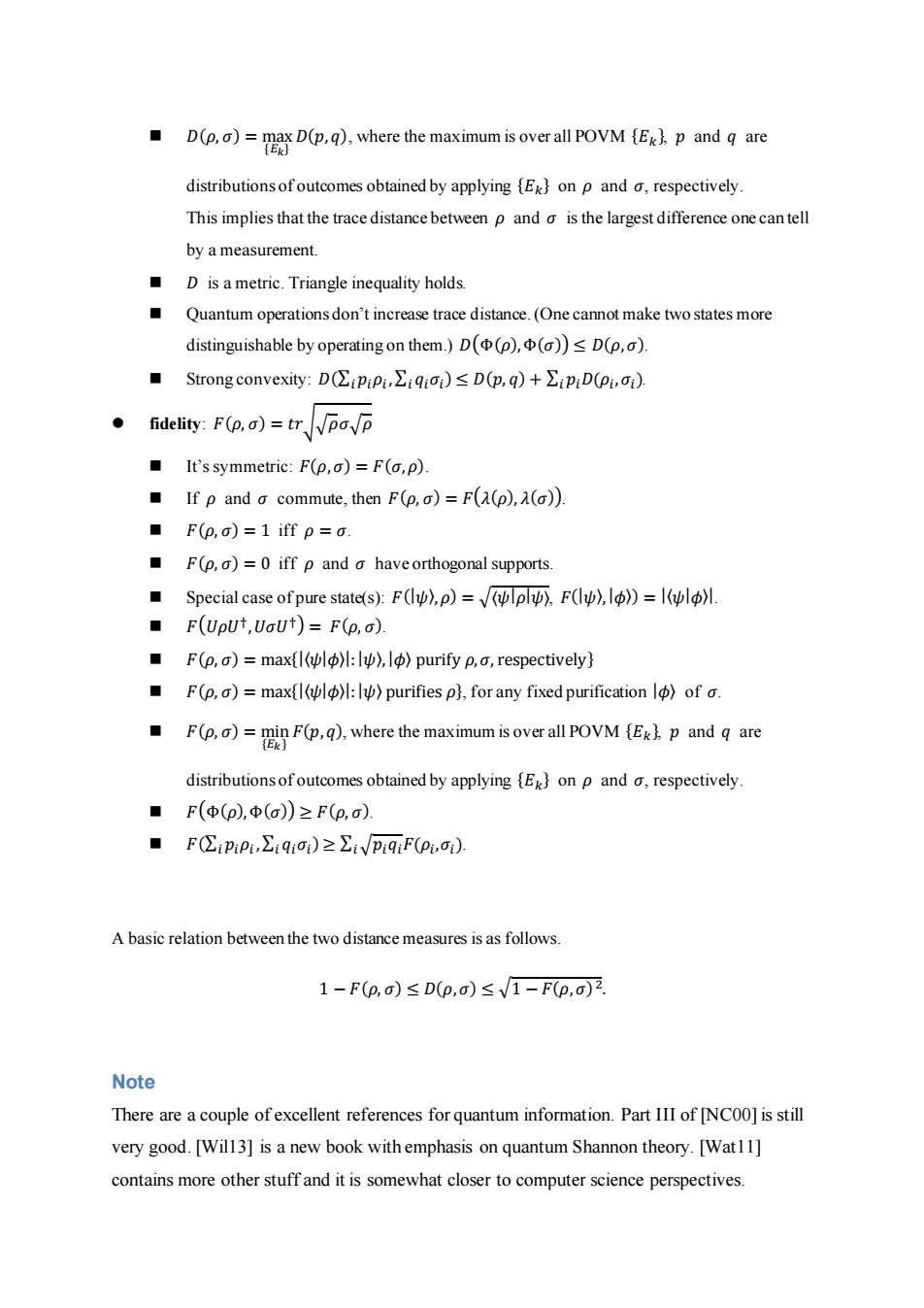正在加载图片...

D(p)(p.),where the maximum is over all POVM p and are distributions of outcomes obtained by applying [Ek}on p and o,respectively. This implies that the trace distance between p and o is the largest difference one can tell by a measurement. ■ D is a metric.Triangle inequality holds. Quantum operations don't increase trace distance.(One cannot make two states more distinguishable by operating on them.)D((p),())D(p,) ■Strong convexity:D(iPiPi,∑iqioi)≤D(p,q)+∑ipiD(pi,oi) 。fidelity:Fo,o)=trpa万 It's symmetric:F(p,o)=F(a,p). If p and o commute,then F(p,a)=F((p),()) ■F(p,o)=1iffp=0. F(p,o)=0 iff p and o haveorthogonal supports Special case of pure state(s):F(),p)=)F())=) F(UpUt,UoUt)=F(p,a). F(p,a)=max{):),lo)purify p,o,respectively} F(p,o)=max{l):l)purifies p},for any fixed purification lo)of a. F(p)(.).where the maximum is over all POVM Ex p and q are distributions ofoutcomes obtained by applying [Ek}on p and o,respectively ■F((p),Φ(a)≥F(p,o). ■ FCiPiP1,∑iqio)≥∑iPiqiF(P,o) A basic relation between the two distance measures is as follows. 1-F(p,o)≤D(p,o)≤V1-F(0,G)2 Note There are a couple of excellent references for quantum information.Part III of [NC0O]is still very good.[Will3]is a new book with emphasis on quantum Shannon theory.[Wat11] contains more other stuff and it is somewhat closer to computer science perspectives.◼ 𝐷(𝜌, 𝜎) = max {𝐸𝑘} 𝐷(𝑝,𝑞), where the maximum is over all POVM {𝐸𝑘 }, 𝑝 and 𝑞 are distributions of outcomes obtained by applying {𝐸𝑘 } on 𝜌 and 𝜎, respectively. This implies that the trace distance between 𝜌 and 𝜎 is the largest difference one can tell by a measurement. ◼ 𝐷 is a metric. Triangle inequality holds. ◼ Quantum operations don’t increase trace distance. (One cannot make two states more distinguishable by operating on them.) 𝐷(Φ(𝜌),Φ(𝜎)) ≤ 𝐷(𝜌,𝜎). ◼ Strong convexity: 𝐷(∑𝑖 𝑝𝑖𝜌𝑖 ,∑𝑖 𝑞𝑖𝜎𝑖 ) ≤ 𝐷(𝑝, 𝑞) + ∑ 𝑝𝑖𝐷(𝜌𝑖 𝑖 ,𝜎𝑖). ⚫ fidelity: 𝐹(𝜌, 𝜎) = 𝑡𝑟√√𝜌𝜎√𝜌 ◼ It’s symmetric: 𝐹(𝜌,𝜎) = 𝐹(𝜎,𝜌). ◼ If 𝜌 and 𝜎 commute, then 𝐹(𝜌, 𝜎) = 𝐹(𝜆(𝜌), 𝜆(𝜎)). ◼ 𝐹(𝜌, 𝜎) = 1 iff 𝜌 = 𝜎. ◼ 𝐹(𝜌, 𝜎) = 0 iff 𝜌 and 𝜎 have orthogonal supports. ◼ Special case of pure state(s): 𝐹(|𝜓〉,𝜌) = √〈𝜓|𝜌|𝜓〉, 𝐹(|𝜓〉,|𝜙〉) = |〈𝜓|𝜙〉|. ◼ 𝐹(𝑈𝜌𝑈† ,𝑈𝜎𝑈†) = 𝐹(𝜌, 𝜎). ◼ 𝐹(𝜌, 𝜎) = max{|〈𝜓|𝜙〉|:|𝜓〉,|𝜙〉 purify 𝜌,𝜎, respectively} ◼ 𝐹(𝜌, 𝜎) = max{|〈𝜓|𝜙〉|:|𝜓〉 purifies 𝜌}, for any fixed purification |𝜙〉 of 𝜎. ◼ 𝐹(𝜌, 𝜎) = min {𝐸𝑘} 𝐹(𝑝,𝑞), where the maximum is over all POVM {𝐸𝑘 }, 𝑝 and 𝑞 are distributions of outcomes obtained by applying {𝐸𝑘 } on 𝜌 and 𝜎, respectively. ◼ 𝐹(Φ(𝜌),Φ(𝜎)) ≥ 𝐹(𝜌, 𝜎). ◼ 𝐹(∑𝑖 𝑝𝑖𝜌𝑖 ,∑𝑖 𝑞𝑖𝜎𝑖 ) ≥ ∑ √𝑝𝑖𝑞𝑖𝐹(𝜌𝑖 𝑖 ,𝜎𝑖). A basic relation between the two distance measures is as follows. 1 − 𝐹(𝜌, 𝜎) ≤ 𝐷(𝜌,𝜎) ≤ √1 − 𝐹(𝜌,𝜎) 2 . Note There are a couple of excellent references for quantum information. Part III of [NC00] is still very good. [Wil13] is a new book with emphasis on quantum Shannon theory. [Wat11] contains more other stuff and it is somewhat closer to computer science perspectives